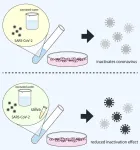(Press-News.org) Yerba mate, along with tea and coffee, is one of the world’s most popular caffeinated beverages. Widely consumed in South America, this remarkable plant is rich in diverse, bioactive compounds that contribute many health benefits.
An international group of researchers has mapped the yerba mate genome, providing insights into the biosynthesis of caffeine in yerba mate. This new information provides opportunities for creating plant varieties with new characteristics.
The work, led by the University of Buenos Aires, involved scientists from EMBL Hamburg and several institutes in Argentina, Brazil, and United States.
Evolution of caffeine in yerba mate
To uncover key aspects of yerba mate’s genetic makeup, the scientists employed genome analysis. It revealed surprising facts about the plant’s biochemistry and its evolutionary history – in particular, the evolution of caffeine biosynthesis.
“I discovered that an ancestor of yerba had duplicated its genome approximately 50 million years ago,” said Federico Vignale, the study’s first author and an EMBL Hamburg postdoc. “This ancestral duplication may have been key in the evolution of its metabolic complexity, allowing it to synthesise a wide range of bioactive compounds, such as terpenes, flavonoids, phenols, and xanthines, known for their antioxidant, anti-diabetic, and nervous system stimulant properties. Of all these compounds, my interest focused on caffeine.”
Caffeine is produced by several unrelated plant species, such as yerba mate and coffee, through similar metabolic pathways for its biosynthesis. Yet, the scientists discovered that the genes involved in these pathways evolved independently.
“We came to understand in detail that the genes do not have a common ancestor, but come from separate origins, and that both yerba mate and coffee came to have caffeine biosynthesis by evolving along convergent pathways,” said Adrián Turjanski, the project leader and a researcher at the Institute of Biological Chemistry in the Faculty of Exact and Natural Sciences at the University of Buenos Aires (IQUIBICEN, UBA-CONICET).
The parallel evolution of caffeine synthesis in yerba mate and coffee led scientists to suspect it plays a crucial role in plant survival, potentially functioning as a defence mechanism.
Through detailed structural, experimental, and bioinformatic analysis, the scientists identified which pathways led to a specificity in caffeine biosynthesis that was different from the coffee plant.
Paving the way for next-generation yerba mate
The findings not only revealed yerba mate’s evolutionary history, but they might also open opportunities to advance how it is cultivated.
“By reading the genome you would know how to intervene and modify the plant,” Turjanski said. “One could propose making it richer in certain characteristics, for example, a decaffeinated yerba mate, or one that is better adapted to other lands, and thus expand its cultivation.”
The team stressed that it is in this context that the foundation for this kind of work has been laid, so other groups working specifically with yerba mate can carry out new studies and, in turn, the industry can create new strains that either assist growers or satisfy user’s tastes.
For Vignale, the cultural significance of yerba mate in South America goes beyond its scientific implications, adding a deeply personal dimension to this research.
“Yerba mate, for me, represents the most beautiful thing about the culture of my home country, Argentina – a drink that unites us, accompanies us, and is present in every moment of our lives,” he said. “That's why I didn't hesitate for a second to accept the challenge. Sequencing the yerba mate genome felt, in a way, like sequencing Messi's genome.”
Collaboration across continents
The project was led by the Faculty of Exact and Natural Sciences at the University of Buenos Aires in collaboration with scientists from EMBL Hamburg, as well as IQUIBICEN-CONICET, Universidad Nacional de Misiones, and Universidad Nacional del Nordeste in Argentina; Instituto Tecnológico Vale in Brazil; and the University of Illinois at Urbana-Champaign, Western Michigan University, and University of California Davis in the United States.
To uncover the caffeine biosynthetic pathway in yerba mate, EMBL Hamburg provided key insights through structural modelling and molecular docking. The expertise provided by Vignale and his colleague Lucas Defelipe, members of EMBL Hamburg’s García Alai Team, played a crucial role in this process.
“This experience taught me the true value of interdisciplinary work and to grow together with scientists from different specialties,” Vignale said.
Vignale’s first interaction with EMBL was through CABANA, a project run by an international consortium of Latin American organisations and EMBL-EBI. Funded by the UKRI Global Challenges Research Fund, it aimed to strengthen bioinformatics capacity across Latin America and supported research to address challenges faced by developing countries. The CABANA project itself aimed to tackle three global challenges: communicable disease, sustainable food production, and protection of biodiversity.
Vignale added, “the CABANA project has not only strengthened my bioinformatics skills, which were essential for carrying out this research, but it also provided the necessary funding to complete the study.”
This article has been adapted from a press release by the Faculty of Exact and Natural Sciences at the University of Buenos Aires. Find the original story here.
END
Mapping the yerba mate genome reveals surprising facts about the evolution of caffeine
Yerba mate genome reveals surprising facts about caffeine’s evolution and offers potential future agricultural opportunities
2025-02-03
ELSE PRESS RELEASES FROM THIS DATE:
Electricity prices across Europe to stabilise if 2030 targets for renewable energy are met, study suggests
2025-02-03
Hitting the current national 2030 quotas for solar and wind energy could reduce the volatility of electricity markets by an average of 20% across 29 European countries, according to a new study from the University of Cambridge.
The intensity of spikes in power prices are predicted to fall in every country by the end of the decade if commitments to green energy are met, as natural gas dependency is cut.
The UK and Ireland would be the biggest beneficiaries, with 44% and 43% reductions in the severity of electricity price spikes by 2030, compared with last year.
Germany could experience a 31% decline in electricity price ...
Improved treatment timing reduces honey bee losses to Varroa mites
2025-02-03
Honey bee mortality can be significantly reduced by ensuring that treatments for the parasitic Varroa mite occur within specific timeframes, a new study reveals.
The mites—belonging to the species Varroa destructor—feed on the larvae of bees and can destroy colonies if not treated at key points to reduce or remove infestations.
But researchers have found that more than a third of beekeepers surveyed in England and Wales deviate from recommended treatment guidelines, including application windows.
Crucially, they found that beekeepers who mistimed Varroa mite treatments experienced exacerbated colony losses, with the effect occurring ...
CAR-T cells can arm bystander T cells with CAR molecules via trogocytosis
2025-02-03
Engineered immune cells called CAR-T cells are used in the treatment of cancer. Researchers from Uppsala University have now discovered that CAR molecules can be transferred from the CAR-T cells to other T cells in the tumour microenvironment. The researchers also pinpoint how this transfer is regulated, which may be used to improve the efficacy of CAR-T cell therapy. The study has been published in the journal Science Immunology.
Immune cells have a capacity to exchange cell surface molecules between one another. This exchange is called trogocytosis and may potentially impact the immune response since it allows different proteins to be transferred between cells.
Chimeric antigen ...
Can ocean-floor mining oversights help us regulate space debris and mining on the Moon?
2025-02-03
by Nishith Mishra, Martina Elia Vitoloni, and Dr Joseph Pelton
Mining ocean resources needed for electric cars and other devices is currently a hot issue of dispute. Final resolution of how or whether the seabed should be expl18oited is pending. Outcomes in this contentious area could create precedents that could impact decisions about mining the moon.
These precedents might shape the how and why of mining the Moon and shape the future and the sustainability of space activities of human beings. But this is only one possible precedent that could reshape the future of space.
Pending international discussions on space traffic management, space debris removal, and limiting ...
Observing ozonated water’s effectiveness against SARS-CoV-2 in saliva
2025-02-03
Disinfecting surfaces is crucial in keeping bacteria and viruses at bay, but the cleaning solutions could be ineffective if met with neutralizing compounds.
Ozonated water has a strong disinfection effect on mold and bacteria, and is also shown to work on SARS-CoV-2, which is responsible for COVID-19. The downside is that ozonated water breaks down quickly in the presence of organic matter, which reduces its effectiveness. SARS-CoV-2 is transmitted through droplets mixed with bodily fluids, such as saliva and nasal mucus which contain organic matters. For this reason, it is necessary to investigate how effective ozonated water is in the presence of ...
Alcohol-related deaths up 18% during pandemic
2025-02-03
Alcohol-related deaths increased 18% during the pandemic, as did hospitalizations related to alcohol use, according to new research in CMAJ (Canadian Medical Association Journal) https://www.cmaj.ca/lookup/doi/10.1503/cmaj.241146.
In the early part of the pandemic, retail alcohol sales volume in Canada increased by 2% (2020/21 v. 2019), the highest increase in 10 years, despite few international visitors. More than 1 in 4 people (26%) reported drinking more, and 18% reported heavy drinking (defined as ...
Mothers of twins face a higher risk of heart disease in the year after birth
2025-02-03
The risk of being admitted to the hospital with heart disease is twice as high the year after birth for mothers of twins compared to singleton births, according to research published in the European Heart Journal [1] today (Monday). The risk is even higher in mothers of twins who had a high blood pressure condition during pregnancy.
The research was led by Professor Cande Ananth from the Department of obstetrics, gynecology, and reproductive sciences at Rutgers Robert Wood Johnson Medical School, New Jersey, USA.
He said: “The rate of twin pregnancies worldwide ...
A new approach to detecting Alzheimer’s disease
2025-02-03
Research led by Lancaster University has revealed clear evidence that changes in the orchestration of brain oxygenation dynamics and neuronal function in Alzheimer’s disease contribute to the neurodegeneration.
The study “Neurovascular phase coherence is altered in Alzheimer’s Disease” is published in Brain Communications. The lead author is Aneta Stefanovska with Juliane Bjerkan, Gemma Lancaster, Peter McClintock and Trevor Crawford from Lancaster University and Bernard Meglič and Jan Kobal from the University of Ljubljana Medical Centre in Slovenia.
Professor Stefanovska said: “Alzheimer's can be hypothesised as being a result ...
Could the contraceptive pill reduce risk of ovarian cancer?
2025-02-02
It’s a little pill with big responsibilities. But despite its primary role to prevent pregnancy, the contraceptive pill (or ‘the Pill’) could also help reduce the risk of ovarian cancer, according to new research from the University of South Australia.
Screening for risk factors of ovarian cancer using artificial intelligence, UniSA researchers found that the oral contraceptive pill reduced the risk of ovarian cancer by 26% among women who had ever used the Pill, and by 43% for women who had used the Pill after the age of 45.
The study also identified some biomarkers associated with ovarian cancer risk, including several characteristics of red blood ...
Launch of the most comprehensive, and up to date European Wetland Map
2025-02-02
2nd February 2025 Greifswald/Aarhus/Helsinki - On time for World Wetlands Day, the European Wetland Map (‘EWM’) significantly enhances knowledge of wetlands across Europe by locating, assessing and merging the latest geospatial data. It combines various geographic information system (GIS) data on wetland types and their distribution on mineral soil in coastal environments, floodplains, and a large variety of peatlands in one most comprehensive, easily accessible resource.
"Over a period of two years, we collected, checked and merged more than 200 geodata on wetlands and especially ...
LAST 30 PRESS RELEASES:
Heart-brain connection: international study reveals the role of the vagus nerve in keeping the heart young
Researchers identify Rb1 as a predictive biomarker for a new therapeutic strategy in some breast cancers
Survey reveals ethical gaps slowing AI adoption in pediatric surgery
Stimulant ADHD medications work differently than thought
AI overestimates how smart people are, according to HSE economists
HSE researchers create genome-wide map of quadruplexes
Scientists boost cell "powerhouses" to burn more calories
Automatic label checking: The missing step in making reliable medical AI
Low daily alcohol intake linked to 50% heightened mouth cancer risk in India
American Meteorological Society announces Rick Spinrad as 2026 President-Elect
Biomass-based carbon capture spotlighted in newly released global climate webinar recording
Illuminating invisible nano pollutants: advanced bioimaging tracks the full journey of emerging nanoscale contaminants in living systems
How does age affect recovery from spinal cord injury?
Novel AI tool offers prognosis for patients with head and neck cancer
Fathers’ microplastic exposure tied to their children’s metabolic problems
Research validates laboratory model for studying high-grade serous ovarian cancer
SIR 2026 delivers transformative breakthroughs in minimally invasive medicine to improve patient care
Stem Cell Reports most downloaded papers of 2025 highlight the breadth and impact of stem cell research
Oxford-led study estimates NHS spends around 3% of its primary and secondary care budget on the health impacts of heat and cold in England
A researcher’s long quest leads to a smart composite breakthrough
Urban wild bees act as “microbial sensors” of city health.
New study finds where you live affects recovery after a hip fracture
Forecasting the impact of fully automated vehicle adoption on US road traffic injuries
Alcohol-related hospitalizations from 2016 to 2022
Semaglutide and hospitalizations in patients with obesity and established cardiovascular disease
Researchers ‘listen in’ to embryo-mother interactions during implantation using a culture system replicating the womb lining
How changing your diet could help save the world
How to make AI truly scalable and reliable for real-time traffic assignment?
Beyond fragmented markets: A new framework for efficient and stable ride-pooling
Can shape priors make road perception more reliable for autonomous driving?
[Press-News.org] Mapping the yerba mate genome reveals surprising facts about the evolution of caffeineYerba mate genome reveals surprising facts about caffeine’s evolution and offers potential future agricultural opportunities




